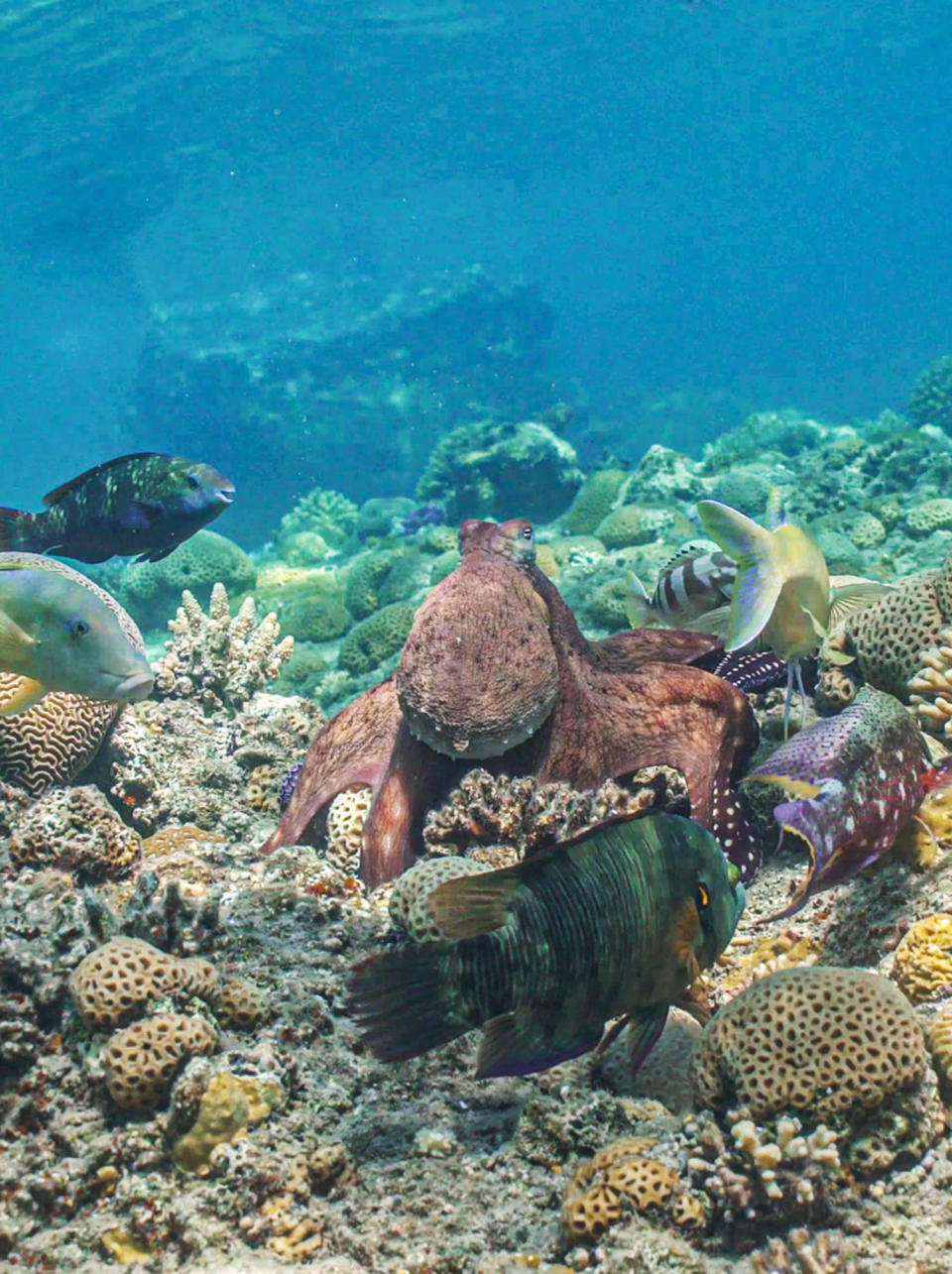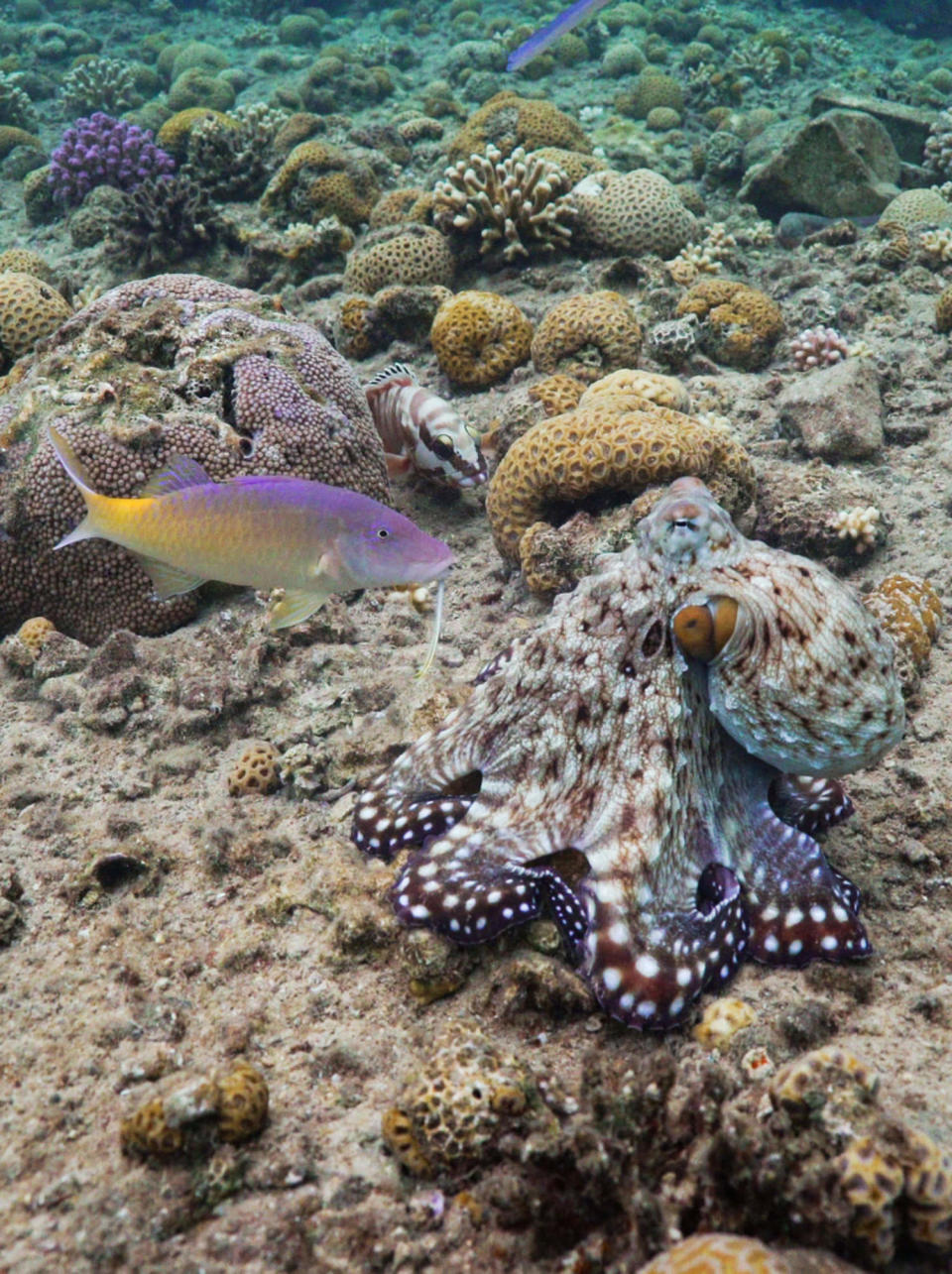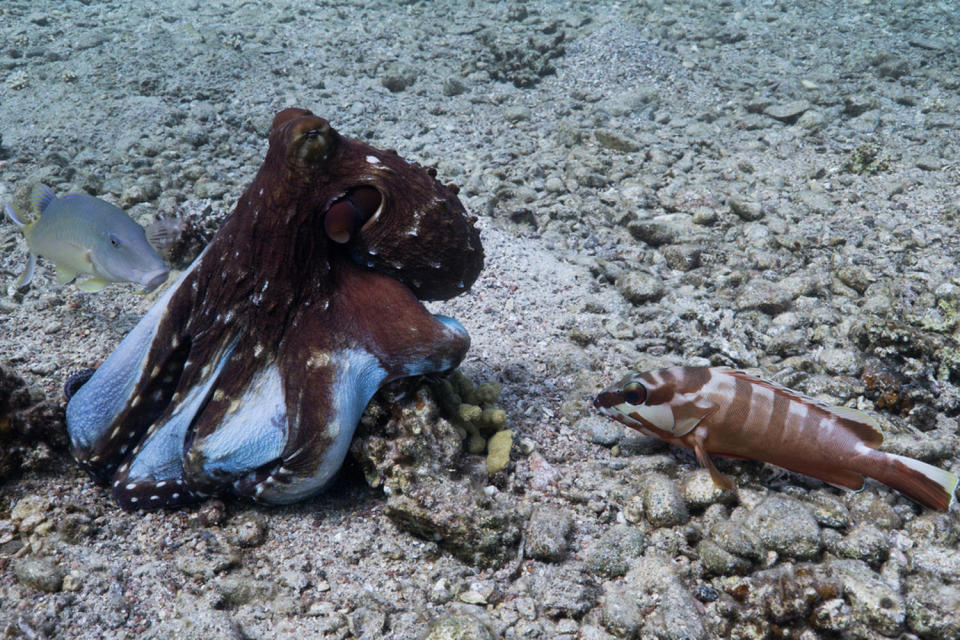The Summary
-
A new study found that some members of an octopus species hunt cooperatively in groups with fish.
-
Video shows octopuses punching their companion fish to keep them on task and contributing to the hunt.
-
The findings indicate that some octopuses have richer social lives than scientists previously understood.
Octopuses don’t always hunt alone — but their partners aren’t who you’d expect.
A new study shows that some members of the species Octopus cyanea maraud around the seafloor in hunting groups with fish, which sometimes include several fish species at once.
The research, published in the journal Nature on Monday, even suggests that the famously intelligent animals organized the hunting groups’ decisions, including what they should prey upon.
What’s more, the researchers witnessed the cephalopod species — often called the big blue or day octopus — punching companion fish, apparently to keep them on task and contributing to the collective effort.
Octopuses have often been thought to avoid other members of their species and prowl solo using camouflage. But the study suggests that some octopuses have surprisingly rich social lives — a finding that opens a new window into the marvels of undersea life. It’s an indication that at least one octopus species has characteristics and markers of intelligence that scientists once considered common only in vertebrates.
“I think sociality, or at least attention to social information, is way more deep-rooted in the evolutionary tree than we might think,” said Eduardo Sampaio, a postdoctoral researcher at the Max Planck Institute of Animal Behavior and the lead author of the research.
“We are very similar to these animals,” he added. “In terms of sentience, they are at a very close level or closer than we think toward us.”


To understand the inner details of octopus lives, researchers dived for about a month at a reef off the coast of Eilat, Israel, and tracked 13 octopuses for a total of 120 hours using several cameras. The team followed the octopuses for 13 hunts, during which they observed groups of between two and 10 fish working with each octopus.
These hunting groups typically included several species of reef fish, such as grouper and goatfish. The octopuses did not appear to lead the groups, but they did punch at fish to enforce social order — most often at blacktip groupers.
“The ones that get more punched are the main exploiters of the group. These are the ambush predators, the ones that don’t move, don’t look for prey,” Sampaio said.
Octopuses would also punch fish to keep the group moving.
“If the group is very still and everyone is around the octopus, it starts punching, but if the group is moving along the habitat, this means that they’re looking for prey, so the octopus is happy. It doesn’t punch anyone,” Sampaio said.
The researchers think fish benefit from such hunting groups because an octopus can reach into crevices where prey hides and root out lunch. The octopus benefits, they believe, because it can simply follow the fish to food, rather than perform what the researchers call speculative hunting.
“For the octopus, it’s also an advantage because it doesn’t need to sample or go around the environment,” Sampaio said. “You can just look at the fish.”
After shooting their video, the researchers fed all of their hunting scenes into software that creates a three-dimensional representation, then used another program to track each animal and log its position in relation to others. The data allowed the researcher to measure how close the creatures remained to one another and which creatures anchored or pulled the group in one direction or another.
The data showed that a particular fish species, the blue goatfish, would roam off and lead the hunting groups in that direction, but the group of fish would linger if the octopus didn’t immediately follow.
The goatfish “are the ones exploring the environment and finding prey,” Sampaio explained. “The octopus is the decider of the group.”


The researchers did not see evidence that the creatures shared prey. All the species involved are generalists that eat crustaceans, fish and mollusks, but whoever was able to catch the prey got a meal.
Questions remain, however, including whether certain octopuses recognize or prefer to hunt with a favorite fish companion.
“Is there a recognition of the individual?” Sampaio said. “Do I want to follow the blue goatfish or do I want to follow Martha because I’ve hunted with Martha before?”
It’s also not clear if this social hunting behavior is something octopuses learn or if it’s innate.
“In my intuition, I think it’s something they learn, because the smaller octopuses seem to have a higher difficulty to collaborate with fish than the large ones,” Sampaio said.
Jonathan Birch, a professor of philosophy at the London School of Economics who studies animal sentience but was not involved in the new research, said he was impressed by the hours of video evidence the scientists collected and their careful coding of the video to quantify the relationships between the creatures.
“It’s an important step beyond what you get in nature documentaries, where individual behavior will get filmed,” Birch said.
He also appreciated that the study’s observations were made outside a laboratory setting, where a lot of animal cognition research takes place. Octopuses can be difficult to study outside their natural setting. “They just seem to be so much more expressive in the wild and be capable of so much more,” he said.


Some scientists subscribe to a theory of evolution called the social brain hypothesis, which says that primates and other animals evolved large brains to process social information and collaborate with others.
“Octopuses were seen as a problem case because they are intelligent and yet solitary, it was assumed, so researchers puzzled for a long time about what’s going on there,” Birch said.
That left two possibilities: Either octopuses indicated that there were paths to intelligence outside of social information, or scientists were missing a hidden piece of octopus lifestyles that fit the social intelligence theory.
“This study seems to shift the balance a bit towards that second theory,” Birch said. “For at least one species of octopus, there is quite a rich social life of a kind.”
This article was originally published on NBCNews.com
